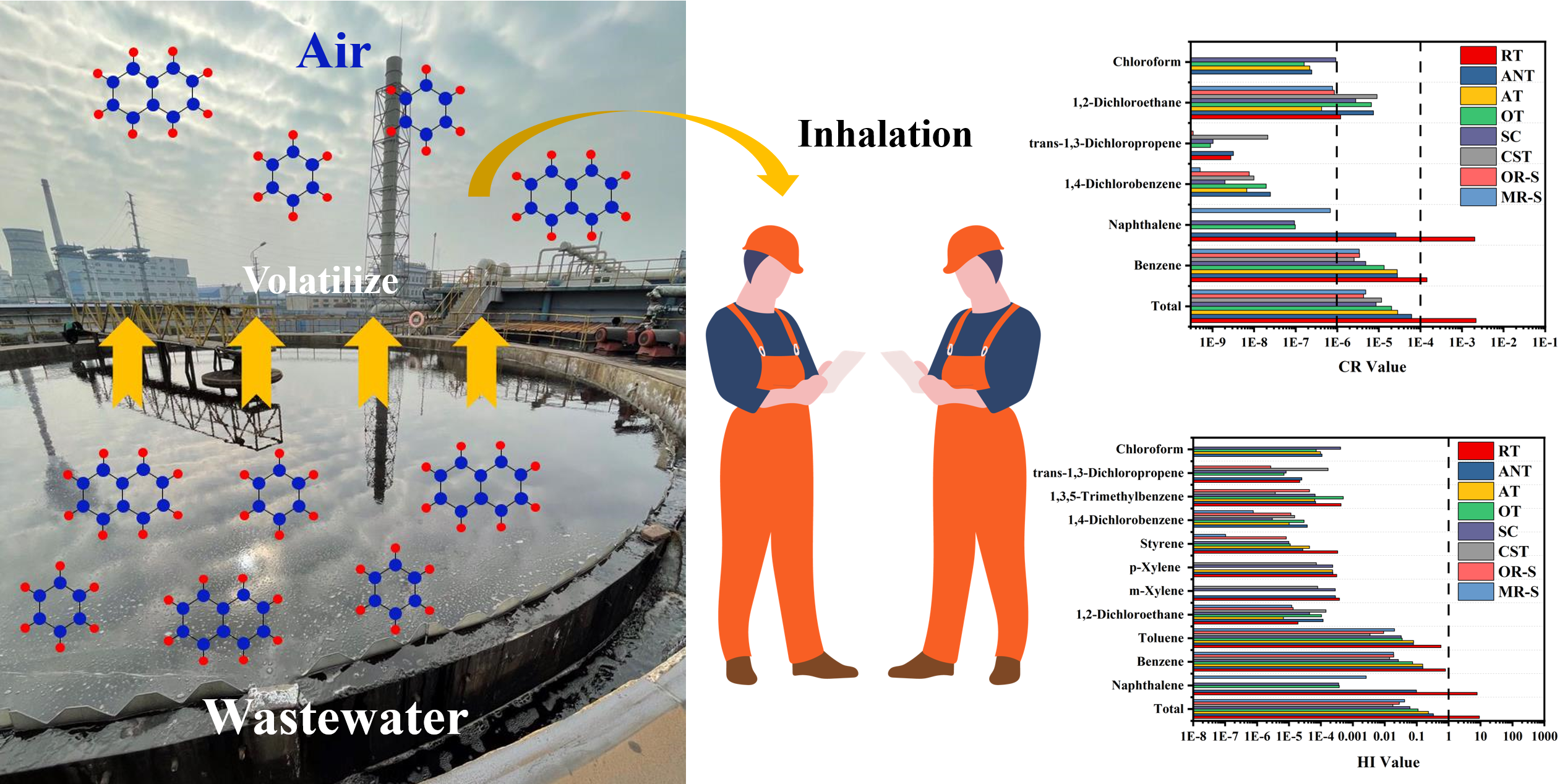近日,广东工业大学环境健康与污染控制研究院、环境科学与工程学院安太成教授团队在国际期刊Science of the Total Environment (2023, 862, 160845) 上发表题为《Distribution characteristics, air-water exchange, ozone formation potential and health risk assessments of VOCs emitted from typical coking wastewater treatment process》的研究论文。论文的第一作者为硕士生汪超,通讯作者为王万军教授。该论文针对焦化污水处理中排放VOCs的健康效应问题,通过对焦化污水处理不同构筑物中水相VOCs和气相VOCs的同步采样分析,评估了VOCs的分布、排放因子及水气交换特征,探明了主要特征污染物及臭氧生成潜势,并进一步评估了特征VOCs的环境健康风险,为焦化行业污水处理排放VOCs的健康风险及其管控策略提供理论基础。

论文网址:http://dx.doi.org/10.1016/j.scitotenv.2022.160845
焦化行业一直被认为是挥发性有机化合物(VOCs)排放的重要来源,然而针对焦化污水处理过程中排放的VOCs的分布特征及其健康效应仍缺乏系统研究。在本研究中,我们聚焦典型焦化污水处理厂不同污水处理构筑物中VOCs的排放特征,系统研究了气相和水相VOCs的分布状态、水-气交换特征、臭氧生成潜势(OFP)及其环境健康风险。研究表明,在气相中检测到30种VOCs,其中苯和萘为主要VOCs,总贡献率达87.81%;在水相中检测到19种VOCs其中苯、萘和甲苯为主要VOCs,总贡献率达75.1%。其中,调节池(RT)是VOCs的主要来源,各处理单元VOCs总排放量为2711.03 g/d,年排放0.99 t。根据污水处理流量,计算得出排放因子为1.36 g VOCs/m3污水。通过引入逸度模型计算了VOCs空气-废水交换通量,发现污染物从水到空气的挥发作用占主导地位。进一步利用获得的VOCs排放因子计算臭氧生成潜势(OFP),结果表明,不同处理构筑物中RT的OFP总量最高(1.52 g O3/m3污水),其中来自甲苯的贡献占总OFP的41.8%,其次是萘,占比达到38.7%。根据EPA推荐的健康风险评估方法计算了排放VOCs的吸入途径健康风险,发现VOCs的总致癌风险在8.60 × 10−6 ~ 2.18 × 10−3之间,其中RT排放VOCs的健康风险超过显著风险阈值(>1 × 10−4),同时RT的非致癌风险(危害商)也超过了风险阈值(>1),其中萘是主要贡献者,占比达到79.02%。本研究不仅为焦化污水处理过程中排放VOCs污染状况和环境风险提供了系统而全面的数据基础,同时也为促进焦化行业VOCs监管和职业健康保护策略的实施提供行业指导。
Graphical Abstract:

英文摘要:
Coking industry has been considered as important source of volatile organic compounds (VOCs) emissions. However, few studies have emphasized the occurrence and adverse effects of VOCs from coking wastewater treatment processes. In this research, pollution profiles of both air and water phase VOCs in a typical coking wastewater treatment plant were investigated in terms of distribution characteristics, air-water exchange, ozone formation potential (OFP) and associated human health risks. Thirty VOCs were detected in the air phase, in which benzene and naphthalene were found to be the major VOCs with total contribution of 87.81%. Nineteen VOCs were detected in the water phase, in which benzene, naphthalene and toluene contribute most to total VOCs with total contribution of 75.1%. The regulating tank (RT) was the major source of VOCs, and the emission rate of total VOCs from all unites was 2711.03 g/d with annual emission of 0.99 t. The emission factor was estimated to be 1.36 g VOCs/m3 wastewater. The air-water exchange was assessed using the Fugacity model, and water-to-air volatilization was predominant based on the net flux of air-water exchange. OFP evaluated by emission factor indicated that the total OFP in RT was the highest (1.52g O3/m3 wastewater), and toluene contributed 41.8% of the total OFP, followed by naphthalene accounting for 38.7% The total carcinogenic risks were in the range of 8.60×10−6 to 2.18×10−3, in which the RT exceeded the significant risk threshold (>1×10-4). The non-carcinogenic risks of hazard quotient value in RT also exceeded the risk threshold (>1), and naphthalene was the major contributor accounting for 79.02%. These results not only provided comprehensive knowledge on pollution profiles and environmental risks of VOCs during coking wastewater treatment processes, but also facilitated the implement of VOCs regulation and occupational health protection strategies in coking industries.